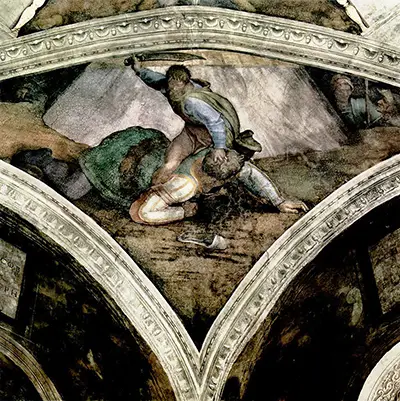In the Valley of Elah, Saul and the Israelites ready to face the Philistines-- each army camps on the opposite side of the valley and for forty days and forty nights, a giant warrior comes to the centre and taunts the Israelites, silencing them. A precocious young shepherd sees their fear and decides to fight the giant. This was the willful David, future king of Israel, and the giant warrior of the Philistine army, the boisterous Goliath. Michelangelo's interpretation, blurry now from centuries of oxidization, still possesses the bright colors and authoritative symmetry of the High Renaissance. His work on the chapel ceiling, done painstakingly with an elaborate self made scaffolding, conveyed a new progression in religious and cultural thought-- its grandeur and beauty made timelessly relevant. Each scene: a vision into a new future.
In the short time it took Michelangelo to complete the momentous task, many pivotal events took place in the world. Columbus had also recently discovered America; the Age of Discovery was set to begin, and Pope Julius II wanted Michelangelo to eternalize the story of Genesis, both in the new and the old world. Spacial and structural, the scenes are detached from earthly boundaries. In this fresco (a name for a method of mural painting with wet lime plaster) David is shown overtop of Goliath in mid action, about to cut off his head. The shepherd king has strikingly bright, blue shirt arms, which are reminiscent of the sky and therefore God's will.
David's expression is calm, and knowing, even stoic-- as if he's carrying out a methodical task of bravery, set forth by destiny. The forms of the faces and bodies are as much driven by sculpture technique as they are by vibrant, arresting colors. Unlike the Book of Samuel implies, Michelangelo's Goliath is portrayed very much still conscious; scrambling to find his footing, desperate and panicked. The juxtaposition of weight adds to the horror of the scene. The sullen men of the Philistine army watch in terror from the left side of the frame, sinking away into the shadows. Goliath's white and yellow sleeves appear petty and overly sophisticated for a warrior of mythical proportions. His attire brings to mind a court jester, which contributes more to the contrast of size, and to his shame. David embodies the power of God through his vessel.



